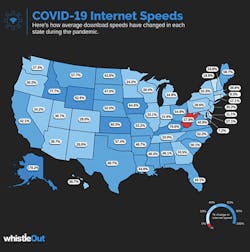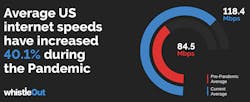Speed: The New Love Language
Are Your Customers Feeling the Network-Love Yet?
The COVID-19 pandemic caused a drastic uptick in remote work and learning from home. It also drove network service providers to increase their Internet speeds. The question is: by how much?
Research by WhistleOut analyzed which states saw a marked increase in their Internet speeds as network service providers answered their customers’ calls for better service. A strong example is Alaska. It leads the pack with an impressive 170% increase in average download speeds thanks to a state-sponsored push to bolster its Internet infrastructure.
The 10 states with the biggest increases:
1. Alaska (170.2% increase in download speeds)
2. Idaho (77.7%)
3. Kentucky (70.6%)
4. Iowa (64%)
5. Wyoming (62.6%)
6. Kansas (60.3%)
7. Maine (59.7%)
8. Montana (57.7%)
9. Oklahoma (57.4%)
10. South Carolina (56.1%)
Another interesting fact is that only 1 state, West Virginia, saw a decrease in download speed in 2021. This is an improvement over 2020, where at least 5 states fell. West Virginia’s average download speed dipped a total of 17.6%—from 59.2Mbps pre-pandemic to 48.7Mbps now. (See Figure 1.)
These changes impact end users’ abilities to weather the unknown impact of the on-going COVID-19 environment. According to WhistleOut, the speeds noted are necessary to enjoy common internet activities:
- Web browsing like Google searches: 1Mbps
- Video streaming like YouTube and Netflix: 3-25Mbps
- Audio streaming like Pandora and Spotify: <1Mbps
- Social media live streaming like Facebook live: 3-6Mbps
- Video calling like Zoom: 3-6Mbps
The average speed is between 50Mbps and 100Mbps, depending on the needs of the household, but those speeds are usually more than enough for up to 4 users.
Thankfully, the national average Internet speed shot up 40.1% from pre-pandemic to year-end 2021. Before COVID-19, the US averaged 84.5Mbps. Since then, speeds further rose to a respectable 118.4Mbps average. (See Figure 2.)
Resources and Notes
https://www.whistleout.com/Internet/Guides/why-is-my-internet-so-slow
"What Internet Speed Do I Need?" by Chris Holmes. whistleOut. January 7, 2021. https://www.whistleout.com/Internet/Guides/internet-speeds-how-fast-do-you-need
"Here’s How (and Why) Internet Speeds Have Changed During COVID-19" by Moe Long. whistleOut. October 12, 2021 https://www.whistleout.com/Internet/Guides/pandemic-internet-speed-changes
BIO TO USE: Moe Long is a Senior Writer for WhistleOut.com. He has over 7 years of experience as a tech media writer. In addition to WhistleOut, Moe has bylines at MakeUseOf, SmartHomeBeginner, DZone, TechBeacon, Elcetromaker, Tech Up Your Life, and DVD Netflix. For more information, please email [email protected] or visit https://www.whistleout.com. Follow Moe on Twitter @mitchellclong and follow WhistleOut on Twitter and LinkedIn @WhistleOut.
About the Author



